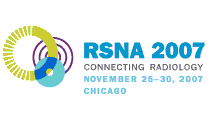
Abstract Archives of the RSNA, 2007
SSC01-07
Projections of Demand and Capacity for Breast MRI Related to Implementation of the 2007 American Cancer Society Guidelines for Screening High-Risk Patients with MRI
Scientific Papers
Presented on November 26, 2007
Presented as part of SSC01: ISP: Breast Imaging (High Risk Screening)
Rand Jordan Stack MD, Presenter: Nothing to Disclose
Peggy Cottrell MS, Abstract Co-Author: Nothing to Disclose
To quantify increased demand for breast MRI resulting from the March 2007 American Cancer Society (ACS) guidelines for MRI screening of patients at high risk for breast cancer and to estimate the cost of implementation and the capacity of the current workforce and facilities to meet this demand.
Prevalence rates of risk factors associated with high risk for breast cancer, direct costs of breast MRI exams, and costs of MRI guided biopsies were taken from the literature. The number of women over age 30 and the number of women who received mantle field radiation therapy for Hodgkin’s disease performed between the years 1955-1974 were based on U.S. census data and ACS incidence statistics and adjusted down to account for mortality.
86.3 million women in the U.S. are over age 30. 1.82 million of these women will need breast MRI exams for high risk of breast cancer (1.73 million for family history, 86,000 women for mutations in the BRCA1 or BRCA2 genes, and 40,000 women for radiation therapy for Hodgkin’s disease in the years 1955-1974). If compliance is 75% (as in mammography) this will be 1.36 million exams.
The increase in breast MRI exams resulting from the ACS recommendations is small compared to the 28 million total MRI exams and 35 million mammograms performed in the U.S. Industry statistics indicate significant excess capacity in MRI scanners.
The direct annual costs for these exams will be $1.4 billion and the cost of false positive screening MRI exams will be $430 million.
If the additional breast MRI exams are divided among the number of radiologists currently interpreting mammograms, the burden would be 94 additional breast MRI exams per radiologist per year. This could be absorbed by the current workforce.
The 2007 ACS guidelines for MRI screening for breast cancer will result in 1.36 million additional breast MRI exams in the U.S. each year at a cost of $1.8 billion. There is sufficient scanner capacity and workforce to absorb the additional volume.
Current workforce and equipment are sufficient to implement the March 2007 ACS guidelines for MRI screening of patients at high risk for breast cancer which will cost $1.8 billion annually.
Stack, R,
Cottrell, P,
Projections of Demand and Capacity for Breast MRI Related to Implementation of the 2007 American Cancer Society Guidelines for Screening High-Risk Patients with MRI. Radiological Society of North America 2007 Scientific Assembly and Annual Meeting, November 25 - November 30, 2007 ,Chicago IL.
http://archive.rsna.org/2007/5004333.html

